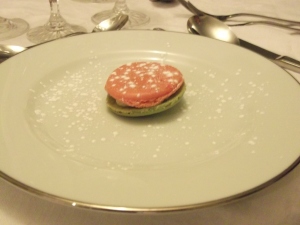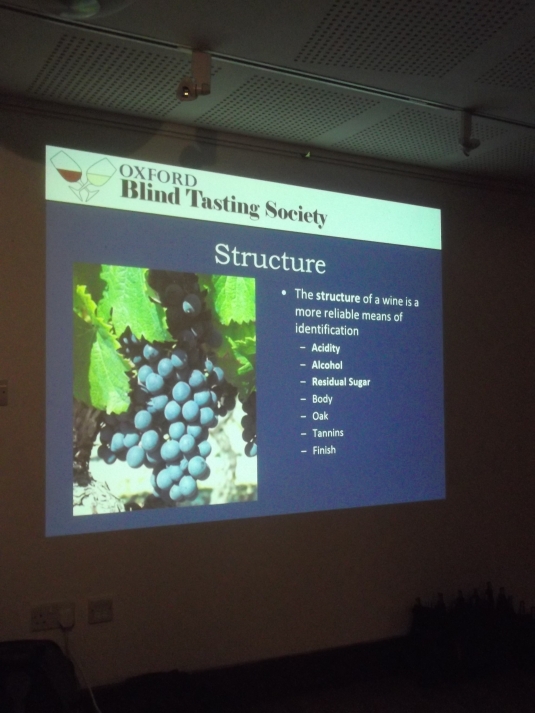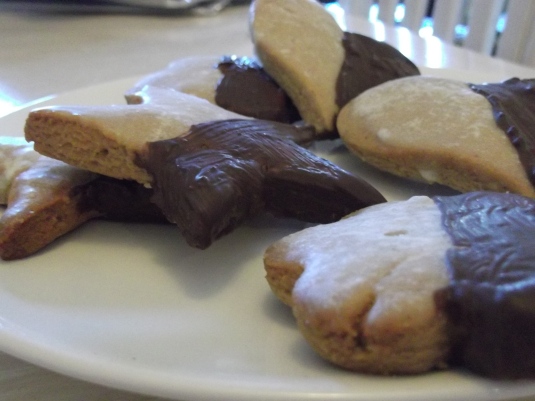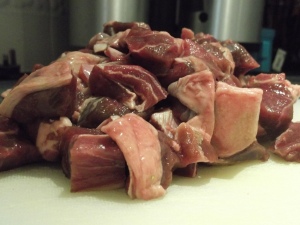Dinner parties are brilliant fun. Great food, great wine, great company. Getting the nice china and wine glasses out for a special occasion. Planning weeks in advance what you will cook. Thinking about food-wine pairings. Spending an entire day beforehand cooking your best stuff to impress guests. Cooking courses you wouldn’t usually cook- starters, soups- when normally all the effort goes into the main and pudding. Really, they are one of my favourite occasions.
But what I have outlined above also constitutes a lot of effort- especially if you want to go for a large number of courses. Similarly, the cost of the cooking ingredients can quickly escalate, and that’s before you even consider the wine. When you have a lot of food to cook and not enough time to cook it in, the process can become very stressful, in addition to the pressures of entertaining you already have. All this adds up to a great time for your guests, but for you? Probably not as much fun as you hoped.
A way I found to reconcile these ideas started in my undergraduate days: collaborative dinner parties. Everybody chips in with one or two courses, bringing wine which pairs well with the food they make. The financial cost and effort is spread around all the guests attending. Everybody can put effort into their course, but benefit from the whole effort the group has put in. There’s still some organising to be done- emailing round beforehand to find enough people, picking courses, and so on- but what you end up with is a brilliant meal that you could never cook on your own.
Here’s the most recent collaborative dinner party I hosted, and if these pictures don’t motivate you to try this idea out, I don’t know what will.

Amuses Bouche: Red Caviar and Russian Black Bread
Wine: Sovetskoye Shampanskoye
What better way to start off a dinner party than Champagne and Caviar? Little red balls of flavour bursting in your mouth, washed down by sparkling wine- definitely woke up my palate. Provided by a friend whose focus is Russian history, I feel we got an authentic Russian experience here, along with some interesting stories about life in Russia. The wine was an eye opener- lots of residual sugar, but went well with the food, the sweetness of the wine complementing the saltiness of the caviar.

Appetiser: Green Thai Curry Macaron
Wine: Faldeos Nevados Torrontés, 2011
Not wanting to overdo the size of this course, the macaron would be little more than a bite of flavour. Sweet almond shells with lime, basil and curry cream filling did just that. The wine pairing was the real success for me, with the Argentinian Torrontés being light and acidic, it balanced everything out.

Starter: Melon with Prosciutto Crudo
Wine: Casa Roscoli Pinot Grigio 2011
From the same friend who brought us Champagne and Caviar, this starter was based on times spent in Italy, living off melon and prosciutto. A classic combination, with the freshness of the lemon, sweetness of the prosciutto, and acidity of the wine all playing their part.
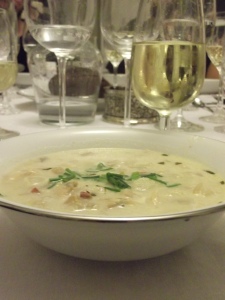
Soup: New England Clam Chowder
Wine: Richter Erdener Treppchen Riesling Spätlese, Mosel, 2009
Made for us by a native of New England, the clam chowder was rich, creamy, sweet and heartening- really capturing that chapter of Moby Dick which always gets me excited about this dish. The wine was one of my favourites bottles of the night, a lovely sweet Riesling from Germany. At only 8.5% alcohol you might think it would not stand up to the dish, but with plenty of acidity and a long finish it worked well. The sweetness of the wine brought out the sweetness of the clams- just a pity there were still ten courses to go, so I couldn’t have seconds.

Shellfish: Prawn Satay Skewers
Wine: Vouvray Grenouilles Demi Sec Careme, 2009
Another sweeter wine complementing the natural sweetness of the shellfish, but balanced out by the strong flavours of the satay sauce. I prefer satay sauce to be really peanutty, and this one hit the spot. Just a mouthful of prawn here, but plenty of taste, and with fourteen courses, that’s just what you want.

Fish: Sakana-san
Wine: Sawanotsuru
Going to a Japanese themed course here. Tempura battered whitebait, a miso ice cream, and a trout and wasabi mousse, all piped into a Japanese character (I think meaning “I caught this in my net”). Paired with a warmed Sake, the wine just let the food speak for itself. Which wasn’t hard- there was a lot to like.

Pasta: Millefeille
Wine: Bricco Rosso Suagna Langhe Rosso 2008
Pasta is always a hard course to assign, because not many people have a pasta maker. But a friend did a great job of this course, with herbs rolled into the pasta dough, and a pepper and chicken filling for the tower. Sprinkled with Parmesan, the course was just the right size for a large meal like this- pasta is course which is easy to over-do and cook too much of. Paired with an Italian red, the ripe fruit and heat of the wine brought out the spicy chicken and peppers, working very nicely.
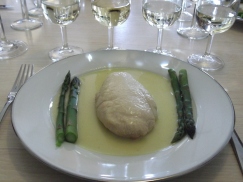
Poultry: Chicken two ways
Wine: La Clape, Arpège, Château Rouquette-Sur-Mer, 2011
Of course there would be one course I forgot to take a picture of, even worse that it is of Mrs. Oxfood’s course, so here is an old photo instead. There were two varieties of chicken here: lime and coriander, and paprika, all served with a sweet chilli dipping sauce. Real contrasts, loads going on. The wine was 90% Roussanne, a grape from the south of France, which was full, fruity, and well balanced. Probably my favourite food-wine pairing of the evening, just for the ability of the Roussanne to deal with what was a very complex course.

Game: Venison Bolegnese
Wine: Barolo Villa Peironte 2008
One of the most enjoyed courses of the evening, a beautifully cooked piece of venison loin, slow cooked venison shoulder, and polenta cakes was served for the game course. The dish was rustic- in a good way- with the grainy polenta cakes really adding something to the texture of the course, balancing everything out. The wine really sung here too. When you have a big wine like Barolo, you need something really meaty to work with, exactly as was done here. Firm tannins, high alcohol, big body- a wine which benefited greatly from decanting.

Cheese: Saint Nectaire, Comté, Laguiole
Wine: Bodegas Palacios Remondo Rioja ‘La Montesa’ Crianza, 2009
Lovely cheeses here. When going for a cheese course, I think people often try and put too contrasting cheeses out- a Stilton, Brie, and Cheddar on the same board, for instance. But these cheeses worked together very nicely. The wine was a strange Rioja, as it was made from mostly Cabernet Sauvignon, but it had plenty of personality. We just had a taste, then saved the cheese for later.

Sorbet: Quince and Vanilla Sorbet
As it happened, I couldn’t have picked the sorbet much better. Sandwiched between a cheese course and a chocolately orangey pudding, the sorbet was not so much a palate cleanser as it was an intermediary between main and pudding courses. I love quince, not as a fruit to eat, being very dry and woody, but as a fruit to roast, purée, and then use in a variety of dishes as a complementary flavour. After a few hours in the oven, you get a fruit a bit like a cross between a baked apple and a baked pear, so you can see how it worked well with the surrounding courses. A lovely sorbet, one I will certainly make again.
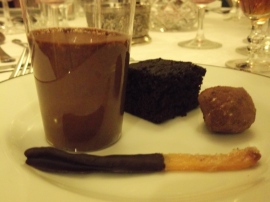
Heavier Pudding: Chocolate, Orange and Spice
Wine: La Concha Palomino Pedro Ximenez
A plate of a chocolate and cardamon mousse, dark chocolate and ginger cake, chocolate and orange truffle, and candied orange peel dipped in dark chocolate. Sound nice? It really was. Top marks as well for the food-wine pairing, the not-so-sticky Pedro Ximenez sherry worked wonderfully allowing the pudding to shine. I always like pairing sherry with puddings, and here is a great example where it helps the dish much better than any wine- or pudding wine- would.
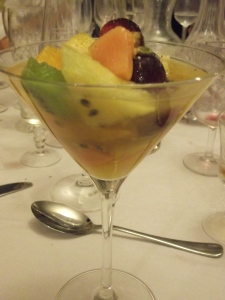
Lighter Pudding: Planters’ Punch Special
Punch was once one of the traditional courses of a very large meal like this, so it was fun to see one served as the lighter pudding. At this point in the meal, you don’t want to see loads of cream on your plate, so a liquid course was very welcome. We didn’t need a wine pairing here either, there was plenty of alcohol already present. Loads of great exotic fruit here, pineapple, grapes, melon, passionfruit- all working very well with the rum in the punch. A good fruit salad is one of my favourite puddings, and I will often choose this over richer fare. A well designed, very tasty course.
 Petit Fours: Pistachio Baklava, Orange and Passion Fruit Marshmallows, Financiers
Petit Fours: Pistachio Baklava, Orange and Passion Fruit Marshmallows, Financiers
Wine: Calvados Pays d’Auge, VSOP
Although most people had eaten their fill at this point, these petit fours still managed to disappear while everyone was sitting at the table chatting after the meal. I had a lot of fun making these, the baklava in particular I had never made before, but they turned out great. The marshmallows were made in a similar fashion to the Pink Fluffy Marshmallows I made previously, just adding a passion fruit and orange syrup to the marshmallow while aerating. Financiers are classic petit fours, rounding the selection out.
For those who haven’t tried Calvados before, it is apple brandy made in the north of France. I think it is brilliant, and a good value for money substitute for brandy like Cognac or Armagnac. The apple flavours in the Calvados added a lot to these petits fours- at least for those who made it this far.
Overall, a brilliant meal. Not surprising, when you consider the amount of effort that went in to it. But with everyone chipping in? I’ll be doing this again.

















